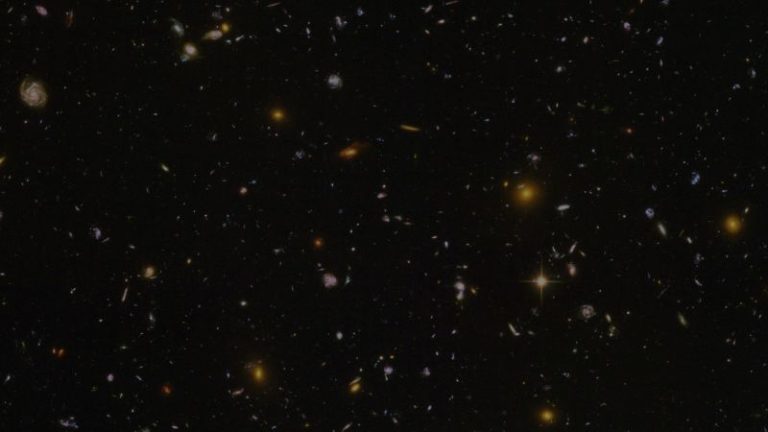Odd radio circles in space have mystified astronomers since the cosmic objects were first discovered in 2019. Now, scientists think they may understand what forms these mysterious celestial structures, and the answer could provide insights into galactic evolution.
The odd radio circles, also known as ORCs, are so massive that entire galaxies reside at their centers, and the objects span hundreds of thousands of light-years.
Our Milky Way galaxy is 30 kiloparsecs across, and one kiloparsec equals 3,260 light-years. The odd radio circles measure hundreds of kiloparsecs across. So far, only 11 have been detected, and some of those are potential ORCs that haven’t been confirmed, according to researchers.
Astronomers have come up with many theories to determine what might form the space rings, including that they’re the result of massive cosmic collisions. But a new study suggests that the circles are shells sculpted by the powerful galactic winds created when massive stars explode.
Pinpointing ORCs
Astronomers first spotted the odd radio circles using the SKA Pathfinder telescope, operated by Australia’s national science agency CSIRO, or Commonwealth Scientific and Industrial Research Organisation.
The telescope can scan large parts of the sky to detect faint signals, which allowed scientists to discover the unusual objects.
Researchers using the South African Radio Astronomy Observatory’s MeerKAT telescope also captured the first image of an ORC, labeled ORC 1, in 2022. (MeerKat is shorthand for Karoo Array Telescope, preceded by the Afrikaans word for “more.”) The powerful telescope is sensitive to faint radio light.
Theories poured in after the odd radio circles were discovered: Perhaps they were the throats of wormholes, the remnants of black hole collisions or powerful jets pumping out energetic particles, researchers hypothesized.
But prior to the new study, the circles had only been observed through radio waves. Despite their massive size, no visible light, infrared or X-ray telescopes detected the odd radio circles.
University of California San Diego professor of astronomy and astrophysics Alison Coil and her collaborators decided to look closely at ORC 4, the first known odd radio circle observable from Earth’s Northern Hemisphere. Coil and her team studied ORC 4 using the W.M. Keck Observatory on Maunakea, Hawaii, which revealed the presence of more luminous heated gas in visible light than seen in typical galaxies.
The finding only sparked more questions.
A missing link
Coil became captivated by the odd radio circles because she and her fellow researchers study massive “starburst galaxies,” which have a high rate of star formation. The galaxies also can drive rapidly outflowing winds. When giant stars explode, they release gas into interstellar space, or the space that exists between stars.
When enough stars explode at once, the force from the explosions can drive the gas out of a starburst galaxy at up to 4,473,873 miles per hour (2,000 kilometers per second).
“These galaxies are really interesting,” said Coil, lead study author and chair of the University of California San Diego’s department of astronomy and astrophysics, in a statement. “They occur when two big galaxies collide. The merger pushes all the gas into a very small region, which causes an intense burst of star formation. Massive stars burn out quickly and when they die, they expel their gas as outflowing winds.”
Coil and her team thought that the radio rings might be related to starburst galaxies.
By using visible and infrared light data, Coil’s team calculated that the stars within the galaxy inside ORC 4 are 6 billion years old.
“There was a burst of star formation in this galaxy, but it ended roughly a billion years ago,” Coil said.
Then, study coauthor Cassandra Lochhaas, a postdoctoral fellow at the Harvard & Smithsonian Center for Astrophysics, ran simulations to recreate the size and properties of the radio circle that included the amount of gas they detected with the Keck telescope.
Lochhaas’ simulation showed that outflowing galactic winds had blown for 200 million years before ceasing. Then, the forward-moving shockwave continued to send hot gas out of the galaxy, creating the radio circle. Meanwhile, a reverse shock sent cooler gas back into the galaxy.
These events took place over the course of an estimated 750 million years.
The new research was published in the journal Nature and presented at the 243rd meeting of the American Astronomical Society in New Orleans on Monday.
“To make this work you need a high-mass outflow rate, meaning it’s ejecting a lot of material very quickly. And the surrounding gas just outside the galaxy has to be low density, otherwise the shock stalls. These are the two key factors,” Coil said. “It turns out the galaxies we’ve been studying have these high-mass outflow rates. They’re rare, but they do exist. I really do think this points to ORCs originating from some kind of outflowing galactic winds.”
Understanding the origins of odd radio circles also helps astronomers ultimately understand what impact the phenomena may have on shaping galaxies over time.
“ORCs provide a way for us to ‘see’ the winds through radio data and spectroscopy,” Coil said. “This can help us determine how common these extreme outflowing galactic winds are and what the wind life cycle is. They can also help us learn more about galactic evolution: do all massive galaxies go through an ORC phase? Do spiral galaxies turn elliptical when they are no longer forming stars? I think there is a lot we can learn about ORCs and learn from ORCs.”

